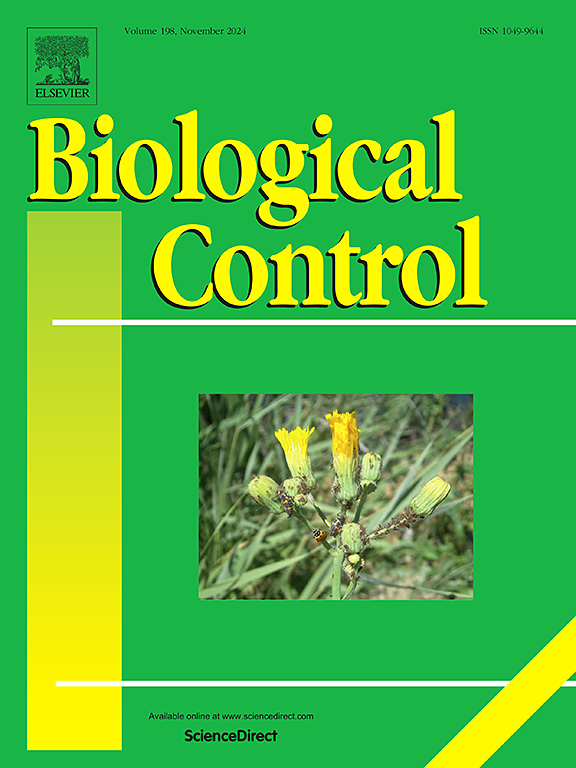短旋乳杆菌对镰刀病的抑制作用及其对环境友好农业的潜在贡献
IF 3.4
2区 农林科学
Q2 BIOTECHNOLOGY & APPLIED MICROBIOLOGY
引用次数: 0
摘要
为了与可持续做法保持一致,全球正在减少化学农药的使用,越来越多的农民正在采用环境友好型农业方法。在这种背景下,乳酸菌(LAB)作为潜在的生物防治剂、生物刺激剂和生物肥料受到越来越多的关注;然而,其作用机制尚不清楚。短乳酸杆菌KB290是一种产生醋酸和乳酸的异发酵菌,副干酪乳杆菌KB182-SBR1202是一种只产生乳酸的同发酵菌,通过乳酸抑制镰刀菌的生长,在体外和自然土壤中,它们的抑制机制正在被探索。在101和106 CFU mL - 1的浓度下,短乳杆菌分别使镰刀菌的生长减少36%和100%,而在106 CFU mL - 1的浓度下,副镰刀菌仅使镰刀菌的生长减少14%。为了解其抑制机制,将乳酸菌培养于液体培养基中,并测定有机酸浓度。副干酪乳杆菌只产生乳酸,而短乳杆菌产生乳酸和乙酸。乳酸和乙酸的ic50分别为18.4 mM和9.72 mM。乙酸完全抑制了镰刀菌的生长,而乳酸在100 mM时没有完全抑制。这表明乙酸的产生是抑制镰刀菌生长的关键因素。短链乳杆菌在受镰刀菌污染的土壤中施用可抑制小松菜镰刀菌病14天。总的来说,这些发现表明,短链乳杆菌有可能在不需要化学农药的情况下有效抑制镰刀菌病,从而支持环境友好型农业做法。本文章由计算机程序翻译,如有差异,请以英文原文为准。
Suppressive effects of Levilactobacillus brevis on Fusarium-plant disease and its potential contribution to environmentally friendly agriculture
To harmonize with sustainable practices, chemical pesticide use is being reduced globally, and more farmers are adopting environmentally friendly agricultural methods. In this context, lactic acid bacteria (LAB) have garnered increasing attention as potential biocontrol agents, biostimulants, and biofertilizers; however, the mechanisms underlying their effects remain unclear. Levilactobacillus brevis KB290, a heterofermentative bacterium that produces acetic and lactic acids, and Lacticaseibacillus paracasei KB182-SBR1202, a homofermentative bacterium that produces only lactic acid via which it suppresses Fusarium growth, both in vitro and in natural soil, are being explored for their inhibitory mechanisms. At concentrations of 101 and 106 CFU mL−1, L. brevis reduced Fusarium growth by 36 % and 100 %, respectively, whereas at concentrations of 106 CFU mL−1 L. paracasei only reduced Fusarium growth by 14 %. To understand the inhibitory mechanism, LAB were cultured in liquid media and organic acid concentrations were measured. L. paracasei produced only lactic acid, whereas L. brevis produced lactic and acetic acids. The IC50s for lactic and acetic acids were 18.4 mM and 9.72 mM, respectively. Acetic acid completely inhibited Fusarium growth, whereas lactic acid did not achieve complete inhibition at 100 mM. This suggests that acetic acid production is a key factor in Fusarium suppression. Application of L. brevis to Fusarium-contaminated soil suppressed Fusarium disease in Japanese mustard spinach (Komatsuna) for up to 14 days. Collectively, these findings suggest that L. brevis has the potential to effectively suppress Fusarium disease without the need for chemical pesticides, thereby supporting environmentally friendly agricultural practices.
求助全文
通过发布文献求助,成功后即可免费获取论文全文。
去求助
来源期刊

Biological Control
生物-昆虫学
CiteScore
7.40
自引率
7.10%
发文量
220
审稿时长
63 days
期刊介绍:
Biological control is an environmentally sound and effective means of reducing or mitigating pests and pest effects through the use of natural enemies. The aim of Biological Control is to promote this science and technology through publication of original research articles and reviews of research and theory. The journal devotes a section to reports on biotechnologies dealing with the elucidation and use of genes or gene products for the enhancement of biological control agents.
The journal encompasses biological control of viral, microbial, nematode, insect, mite, weed, and vertebrate pests in agriculture, aquatic, forest, natural resource, stored product, and urban environments. Biological control of arthropod pests of human and domestic animals is also included. Ecological, molecular, and biotechnological approaches to the understanding of biological control are welcome.
 求助内容:
求助内容: 应助结果提醒方式:
应助结果提醒方式:


